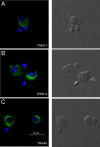Activation of TREK currents by the neuroprotective agent riluzole in mouse sympathetic neurons
- PMID: 21273422
- PMCID: PMC6623616
- DOI: 10.1523/JNEUROSCI.2791-10.2011
Activation of TREK currents by the neuroprotective agent riluzole in mouse sympathetic neurons
Abstract
Background K2P channels play a key role in stabilizing the resting membrane potential, thereby modulating cell excitability in the central and peripheral somatic nervous system. Whole-cell experiments revealed a riluzole-activated current (I(RIL)), transported by potassium, in mouse superior cervical ganglion (mSCG) neurons. The activation of this current by riluzole, linoleic acid, membrane stretch, and internal acidification, its open rectification and insensitivity to most classic potassium channel blockers, indicated that I(RIL) flows through channels of the TREK [two-pore domain weak inwardly rectifying K channel (TWIK)-related K channel] subfamily. Whole-ganglia and single-cell reverse transcription-PCR demonstrated the presence of TREK-1, TREK-2, and TRAAK (TWIK-related arachidonic acid-activated K(+) channel) mRNA, and the expression of these three proteins was confirmed by immunocytochemistry in mSCG neurons. I(RIL) was enhanced by zinc, inhibited by barium and fluoxetine, but unaffected by quinine and ruthenium red, strongly suggesting that it was carried through TREK-1/2 channels. Consistently, a channel with properties identical with the heterologously expressed TREK-2 was recorded in most (75%) cell-attached patches. These results provide the first evidence for the expression of K2P channels in the mammalian autonomic nervous system, and they extend the impact of these channels to the entire nervous system.
Figures







Similar articles
-
PIP2 Mediated Inhibition of TREK Potassium Currents by Bradykinin in Mouse Sympathetic Neurons.Int J Mol Sci. 2020 Jan 8;21(2):389. doi: 10.3390/ijms21020389. Int J Mol Sci. 2020. PMID: 31936257 Free PMC article.
-
Muscarinic modulation of TREK currents in mouse sympathetic superior cervical ganglion neurons.Eur J Neurosci. 2015 Jul;42(2):1797-807. doi: 10.1111/ejn.12930. Epub 2015 May 19. Eur J Neurosci. 2015. PMID: 25899939
-
Contribution of KCNQ and TREK Channels to the Resting Membrane Potential in Sympathetic Neurons at Physiological Temperature.Int J Mol Sci. 2020 Aug 12;21(16):5796. doi: 10.3390/ijms21165796. Int J Mol Sci. 2020. PMID: 32806753 Free PMC article.
-
Therapeutic potential of neuronal two-pore domain potassium-channel modulators.Curr Opin Investig Drugs. 2007 Jul;8(7):555-62. Curr Opin Investig Drugs. 2007. PMID: 17659475 Review.
-
Tandem pore TWIK-related potassium channels and neuroprotection.Neural Regen Res. 2019 Aug;14(8):1293-1308. doi: 10.4103/1673-5374.253506. Neural Regen Res. 2019. PMID: 30964046 Free PMC article. Review.
Cited by
-
Ultrasonic Neuromodulation and Sonogenetics: A New Era for Neural Modulation.Front Physiol. 2020 Jul 16;11:787. doi: 10.3389/fphys.2020.00787. eCollection 2020. Front Physiol. 2020. PMID: 32765294 Free PMC article. Review.
-
Expression of K2P channels in sensory and motor neurons of the autonomic nervous system.J Mol Neurosci. 2012 Sep;48(1):86-96. doi: 10.1007/s12031-012-9780-y. Epub 2012 Apr 29. J Mol Neurosci. 2012. PMID: 22544515
-
The influence of cold temperature on cellular excitability of hippocampal networks.PLoS One. 2012;7(12):e52475. doi: 10.1371/journal.pone.0052475. Epub 2012 Dec 31. PLoS One. 2012. PMID: 23300680 Free PMC article.
-
A Bacterial Toxin with Analgesic Properties: Hyperpolarization of DRG Neurons by Mycolactone.Toxins (Basel). 2017 Jul 18;9(7):227. doi: 10.3390/toxins9070227. Toxins (Basel). 2017. PMID: 28718822 Free PMC article.
-
K2P channel gating mechanisms revealed by structures of TREK-2 and a complex with Prozac.Science. 2015 Mar 13;347(6227):1256-9. doi: 10.1126/science.1261512. Science. 2015. PMID: 25766236 Free PMC article.
References
-
- Altschul SF, Gish W, Miller W, Myers EW, Lipman DJ. Basic local alignment search tool. J Mol Biol. 1990;215:403–410. - PubMed
-
- Bang H, Kim Y, Kim D. TREK-2, a new member of the mechanosensitive tandem-pore K+ channel family. J Biol Chem. 2000;275:17412–17419. - PubMed
-
- Brown DA, Adams PR, Constanti A. Voltage-sensitive K-currents in sympathetic neurons and their modulation by neurotransmitters. J Auton Nerv Syst. 1982;6:23–35. - PubMed
Publication types
MeSH terms
Substances
LinkOut - more resources
Full Text Sources
Other Literature Sources
